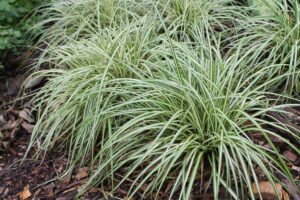Sedge ‘Ice Dance’ and ‘Silver Sceptre’
* Common name: Sedge ‘Ice Dance’ and ‘Silver Sceptre’

Sedge ‘Silver Sceptre’ has showy silver-edged blades.
* Botanical name: Carex morrowii
* What it is: ‘Ice Dance’ and ‘Silver Sceptre’ are two very similar varieties of a grass-like species known as Japanese sedge. Besides the spiky texture, these varieties have silver edges to their green blades, which brighten the shady spots that they prefer.
Japanese sedges look like foot-tall clumps of ornamental grass, but they’re actually a different family with triangular blades.
Plants get brown spikes in mid-spring that aren’t very showy and that can be snipped off if you think they detract from the main show, which is the variegated foliage.
Sedges are largely bug- and disease-free, and deer don’t like them either.
* Size: 12 to 14 inches tall. Clumps slowly expand to about 18 to 24 inches.
* Where to use: Because sedges prefer damp shade, they work best mixed in a shade garden, edging a woodland path, or along the east or north house foundation. They also look good edging or as specimens around a water garden, and they can be massed to make a shady, spiky-textured groundcover.
Japanese sedge also adds texture and leaf color to a flower-pot combination. Shade or part-shade settings are best.
* Care: Foliage can be evergreen in mild winters, so wait until early spring to cut foliage to a stub (just before new growth begins).
Fertilizer usually isn’t needed. Clumps can be dug, divided, and transplanted in early spring.
* Great partner: Variegated sedges look good interplanted with white-blooming bulbs for early-spring color, such as snowflakes, white daffodils, or white tulips. Shade-preferring, white-blooming annuals make good summer partners, such as impatiens, torenia, or begonias. Wide-leafed perennials such as hosta and coralbells make good form contrasts. And smooth hydrangeas and fothergilla are two white-blooming shrubs that like the same damp, shaded locations as Japanese sedge.







